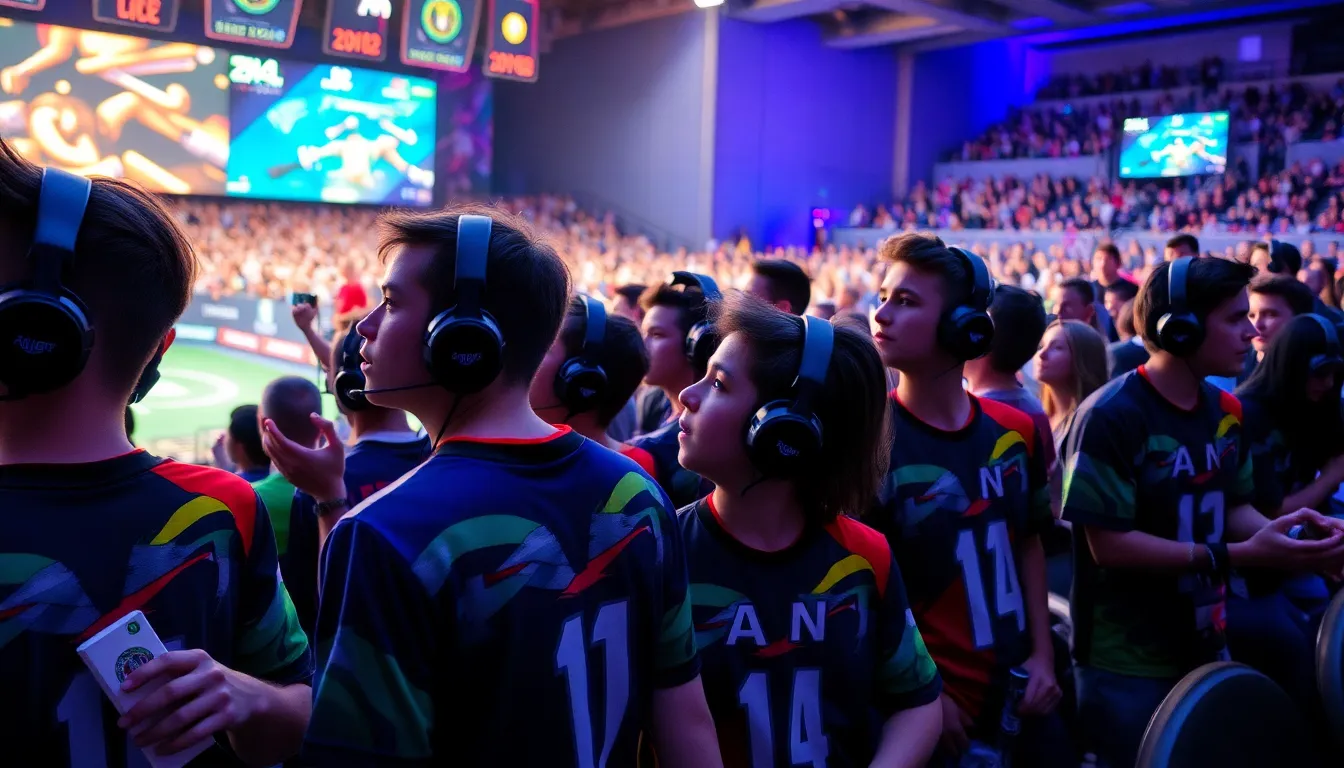In the digital age, the esports fanbase has exploded, transforming a niche hobby into a global phenomenon. Picture this: millions of passionate fans glued to their screens, cheering for their favorite teams as if they were watching the Super Bowl. From epic tournaments to nail-biting rivalries, the excitement is palpable, and the community is thriving.
Table of Contents
ToggleOverview of Esports Fanbase
Esports attracts a vast and diverse fanbase that constantly grows. Millions of fans follow this electrifying realm, forming communities worldwide. Online platforms and social media play vital roles in spreading enthusiasm for competitive gaming.
Fans engage with content through live streams and social networks, creating an immersive experience. In 2022, the global esports audience reached 532 million, with a projected increase to 602 million by 2024. Streaming services like Twitch and YouTube facilitate interactions, allowing fans to connect with teams and players.
Demographics reveal a young audience. Approximately 75% of esports fans are under 35 years old, with many identifying as Generation Z. This engagament foundation drives marketing strategies for brands seeking to tap into the esports market. Companies understand the importance of digital presence, aligning sponsorship deals with popular tournaments and teams.
Intense rivalries generate excitement, drawing comparisons to traditional sports like football and basketball. Fans participate in discussions, highlighting significant moments and favorite players through forums and social media channels. Some even attend live events, experiencing the thrill of competitions in person.
Esports’ growth aligns with advancements in technology. High-speed internet access enhances viewing experiences, enabling fans to watch events in real-time. With the rise of virtual reality and augmented reality, immersion in gaming is poised to reach unprecedented levels. A global phenomenon, esports fosters a sense of belonging, uniting fans from varied backgrounds under a shared passion for gaming.
Key Demographics

The esports fanbase consists of various age groups and gender identities, reflecting its broad appeal.
Age and Gender Distribution
Approximately 75% of esports fans are under 35 years old. This youthful demographic drives the engagement seen across online platforms. Male fans dominate with around 70% of the audience, but female participation continues to grow. With initiatives aimed at inclusivity, women now represent a significant proportion of the fanbase. Growth in diverse audiences is essential for brands targeting this vibrant market.
Geographic Distribution
The esports community spans the globe, with substantial audiences in North America, Europe, and Asia. In 2022, Asia accounted for over 50% of the total esports viewership. North America trails close behind, representing about 25% of the audience. The rising interest in Europe fuels competitive investments, enhancing local spectacles. This geographic distribution impacts marketing strategies as brands cater to regional preferences and trends.
Engagement Levels
Esports engagement varies through several interactive channels, enabling fans to connect deeply with their favorite teams and players. The dynamic nature of fan interaction bolsters community growth.
Social Media Activity
Social media platforms serve as key arenas for esports fans, fostering vibrant discussions and real-time updates. Twitch, Twitter, and Discord play crucial roles in enhancing fan interaction, allowing for direct communication with players. Engagement rates on these platforms reach impressive levels, with surveys indicating that 43% of fans frequently participate in online discussions during events. Content shared, such as memes and highlights, often generates significant buzz, further amplifying community involvement.
Live Event Attendance
Live esports events draw massive crowds, showcasing fans’ dedication to competitive gaming. In 2022, major tournaments attracted attendance exceeding 500,000 fans worldwide, underscoring the popularity of in-person experiences. Events like the League of Legends World Championship and The International deliver thrilling atmospheres filled with excitement. Fans often travel long distances to support their favorite teams, enhancing a shared cultural identity. Approximately 60% of attendees report attending multiple events each year, demonstrating a strong commitment to live participation in the esports scene.
Factors Influencing Fanbase Growth
Understanding the key elements that drive the growth of the esports fanbase reveals the dynamics at play in this rapidly evolving market.
Game Popularity
Game popularity heavily influences fan engagement. Titles that dominate the esports scene, like League of Legends and Dota 2, attract massive viewership. Players and teams build strong followings around these games. High-profile tournaments draw millions of viewers, boosting interest. The competitive nature of these games keeps audiences invested. E-sports fandom often grows with the introduction of new titles or significant updates. As games enhance their mechanics and community events, they inspire fans to support teams and players passionately. Newly released games can create fresh waves of excitement, expanding fan bases significantly.
Streaming Platforms
Streaming platforms serve as vital hubs for fan interaction. Websites like Twitch and YouTube facilitate real-time engagement. Fans connect with their favorite players during live broadcasts, sparking community-driven discussions. Interactive features, such as chat and polls, enhance viewer participation, fostering a sense of belonging. Consequently, the accessibility of these platforms keeps fans returning for more content. Major tournaments broadcast on these channels reach wide audiences. In 2022, Twitch attracted over 140 million unique viewers each month, demonstrating the platform’s role in fan growth. Regularly scheduled events capitalize on peak viewing times, further solidifying a dedicated following.
Challenges Facing Esports Fanbase
Challenges within the esports fanbase complicate its expansion and sustainability. Addressing various issues becomes crucial as the community grows.
Toxicity and Community Issues
Toxic behavior often undermines the positive aspects of the esports community. Players, fans, and streamers encounter harassment and discrimination, causing alienation. Approximately 26% of fans report experiencing or witnessing toxicity during matches. Such behavior discourages new participants from joining and may lead to a decline in overall engagement. Communities actively promoting inclusivity and respect foster healthier environments. Efforts to combat toxicity through moderation and awareness campaigns are essential for nurturing a positive fan experience and ensuring long-term growth.
Market Saturation
Market saturation presents a significant hurdle for the esports fanbase. An influx of games saturates available content, making it challenging for new titles to capture attention. In 2022, over 1,200 esports titles existed, complicating the landscape for fans and players. High competition leads to difficulty in keeping fan interest, especially with players juggling multiple games. Brands struggle to differentiate themselves amid the noise, impacting sponsorship and investment opportunities. Focusing on unique game features and engaging experiences helps retain viewer interest and maintain a vibrant fanbase.
The esports fanbase represents a dynamic and rapidly evolving community that thrives on passion and engagement. With millions of dedicated supporters and a growing global audience the future looks bright for this vibrant scene. As technology continues to advance and new games emerge the potential for further growth remains significant.
However addressing challenges like toxic behavior and market saturation is crucial for sustaining this momentum. By fostering an inclusive and respectful environment esports can continue to attract diverse fans and maintain its status as a major player in the entertainment industry. The journey ahead promises excitement and innovation for both fans and brands alike.


